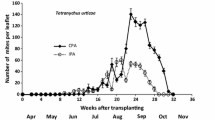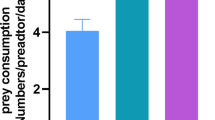Abstract
Greenhouse and field experiments were conducted to evaluate the effectiveness of site-specific tactics for management of the twospotted spider mite, Tetranychus urticae Koch, a major pest of greenhouse and field-grown strawberries (Fragaria x ananassa Duchesne). Two site-specific (spot) treatments, the miticide bifenazate (Acramite®) and the predatory mite Neoseiulus californicus McGregor, were compared with whole-plot treatments of bifenazate or N. californicus to determine whether T. urticae could be effectively managed in field-grown strawberry using only site-specific tactics. Additionally, the cost of site-specific tactics was compared with whole-plot treatments to determine the economic value of using site-specific management tactics for T. urticae in strawberries. In the greenhouse, all treatments equivalently reduced the number of T. urticae below control. In the field during the 2011–2012 season, more T. urticae eggs and motiles were in the whole-plot treatments of both N. californicus and bifenazate in the mid-season and late season, respectively, compared with the spot treatments. With the exception of site-specific N. californicus during the 2011–2012 field season, there were no differences in marketable yields between plots with site-specific treatments and whole-plot management. An economic analysis demonstrated a significant cost savings (75.3 %) with site-specific treatments of N. californicus compared with whole-plot application of N. californicus. Similarly, a 24.7 % reduction in cost was achieved in using site-specific bifenazate compared with whole-plot application of bifenazate. The findings indicate that site-specific treatments with N. californicus and bifenazate are competitive alternatives to whole-field application for T. urticae management in strawberries.




Similar content being viewed by others
References
Arévalo A, Fraulo A, Liburd OE (2009) Management of flower thrips in blueberries in Florida. Fla Entomol 92:14–17
Bernardi D, Bottom M, Silva de Cunha U, Bernardi O, Malausa T, Garcia MS, Nava DE (2013) Effects of azadirachtin on Tetranychus urticae (Acari: Tetranychidae) and its compatibility with predatory mites (Acari: Phytoseiidae) on strawberry. Pest Manag Sci 69:75–80
Bongiovanni R, Lowenberg-DeBoer J (2004) Precision agriculture and sustainability. Precis Agric 5:359–387
Cloyd RA, Galle CL, Keith SR (2006) Compatibility of three miticides with the predatory mites Neoseiulus californicus McGregor and Phytoseiulus persimilis Athias-Henriot (Acari: Phytoseiidae). HortScience 41:707–710
Croft BA, Coop LB (1998) Heat units, release rate, prey density, and plant age effects on dispersal by Neoseiulus fallacis (Acari: Phytoseiidae) after inoculation into strawberry. J Econ Entomol 91:94–100
Dunley JE, Croft BA (1992) Dispersal and gene flow of pesticide resistance traits in phytoseiid and tetranychid mites. Exp Appl Acarol 14:313–325
FAWN (2013) Florida automated weather network report generator. University of Florida, http://fawn.ifas.ufl.edu/data/reports/, Gainesville, Florida
Flint ML (2012) IPM in practice: principles and methods of integrated pest management, 2nd edn. University of California, Oakland
Fraulo AB, Liburd OE (2007) Biological control of twospotted spider mite, Tetranychus urticae Koch, with predatory mite, Neoseiulus californicus, in strawberries. Exp Appl Acarol 43:109–119
Fraulo AB, McSorley R, Liburd OE (2008) Effect of the biological control agent Neoseiulus californicus (Acari: Physeiidae) on arthropod community structure in north Florida strawberry fields. Fla Entomol 91:436–445
Hart AJ, Bale JS, Tullett AG, Worland MR, Walters KFA (2002) Effects of temperature on the establishment potential of the predatory mite Amblyseius californicus Mcgregor (Acari: Phytoseiidae) in the UK. J Insect Physiol 48:593–599
Hiragaki S, Kobayashi T, Ochiai N, Toshima K, Dekeyser MA, Matsuda K, Takeda M (2012) A novel action of highly specific acaricide; bifenazate as a synergist for a GABA-gated chloride channel of Tetranychus urticae [Acari: Tetranychidae]. Neurotoxicology 33:307–313
Liburd OE, White JC, Rhodes EM, Browdy AA (2007) The residual and direct effects of reduced-risk and conventional miticides on twospotted spider mites, Tetranychus urticae (Acari: Tetranychidae) and predatory mites (Acari: Phytoseiidae). Fla Entomol 90:249–257
Nyoike TW (2012) Incorporating economic thresholds and geospatial information technology (git) into pest management for twospotted spider mites in strawberries. A Ph.D. dissertation submitted to the graduate school in partial fulfillment of the requirements for the Doctor of Philosophy degree. August 2012, University of Florida, Gainesville, Florida
Nyoike TW, Liburd OE (2013) Effect of twospotted spider mite, Tetranychus urticae Koch (Acari: Tetranychidae) on marketable yields of field-grown strawberries in north-central Florida. J Econ Entomol 106:1757–1766
Nyoike TW, Mekete T, McSorley R, Weibezahl-Kakarigi E, Liburd OE (2012) Confirmation of Meloidogyne hapla on strawberry in Florida using molecular and morphological techniques. Nematropica 42:253–259
Plant RE (2001) Site-specific management: the application of information technology to crop production. Comput Electron Agric 30:9–29
Rhodes EM, Liburd OE (2006) Evaluation of N. californicus and Acramite® for control of twospotted spider mites in strawberries in north-central Florida. J Econ Entomol 99:1291–1298
Rhodes EM, Liburd OE, Kelts C, Rondon SI, Francis RR (2006) Comparison of single and combination treatments of Phytoseiulus persimilis, Neoseiulus californicus, and Acramite (bifenazate) for control of twospotted spider mites in strawberries. Exp Appl Acarol 39:213–225
Sances FV, Wyman JA, Ting IP, van Steenwyk RA, Oatman ER (1981) Spider mite interactions with photosynthesis, transpiration and productivity of strawberry. Environ Entomol 10:442–448
SAS Institute (2007) PROC user’s manual, version, 3rd edn. SAS Institute, Cary
Schausberger P, Walzer A (2001) Combined versus single species release of predaceous mites: predator–predator interactions and pest suppression. Biol Control 20:269–278
Senay GB, Ward AD, Lyon JG, Fausey NR, Nokes SE (2000) Manipulation of high spatial resolution aircraft remote sensing data for use in site-specific farming. T ASAE 41:489–495
Walsh DB, Zalom FG, Shaw DV, Larson KD (2002) Yield reduction caused by twospotted spider mite feeding in an advanced-cycle strawberry breeding population. J Am Soc Hort Sci 127:230–237
Walzer A, Blumel S, Schausberger P (2001) Population dynamics of interacting predatory mites, Phytoseiulus persimilis and Neoseiulus californicus, held on detached bean leaves. Exp Appl Acarol 25:731–743
Whitaker VM, Boyd NS, Peres NA, Smith HA (2014) (revised) Strawberry production. Publication # HS736. EDIS-IFAS. University of Florida, Gainesville. FL 32611
White JC, Liburd OE (2004) Effects of soil moisture and temperature on reproduction and development of twospotted spider mite (Acari: Tetranychidae) in strawberries. J Econ Entomol 98:154–158
Acknowledgments
We would like to thank the Small Fruit and Vegetable IPM lab at the University of Florida assistance with field sampling. We would also like to thank Drs. Janine Razze, Elena Rhodes and Robert McSorley for providing earlier reviews of the manuscript. We thank the crew at the University of Florida, Plant Science Research and Education Unit in Citra for their assistance with maintenance of research plots. The project was funded by the Specialty Crop State Block Grant Program; contract # 00080893.
Author information
Authors and Affiliations
Corresponding author
Rights and permissions
About this article
Cite this article
Liu, R., Nyoike, T.W. & Liburd, O.E. Evaluation of site-specific tactics using bifenazate and Neoseiulus californicus for management of Tetranychus urticae (Acari: Tetranychidae) in strawberries. Exp Appl Acarol 70, 189–204 (2016). https://doi.org/10.1007/s10493-016-0073-y
Received:
Accepted:
Published:
Issue Date:
DOI: https://doi.org/10.1007/s10493-016-0073-y




